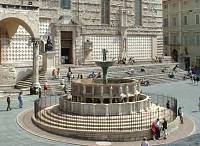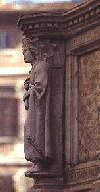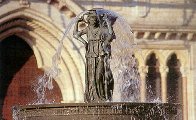|
|
| |||
|
PERUGIA Art and monuments -
Fontana Maggiore
The square was at one time occupied by the bishop’s citadel, but this was demolished to pave the way for the public buildings of the free city.
It was completed between 1275 and 1278, at the arrival point of the Monte Pacciano acqueduct. Fra Bevignate supervised construction, which was carried out by the Pisan sculpturers Nicola (father) and Giovanni (son) Pisano. The fountain is made up of two polygonal basins in white and pink stone, placed one above the other. This structure is in turn surmounted by a bronze basin with a group of three bronze nymphs holding an urn, from where the water gushes. Probably later in date, this group was once topped by four griffins that have since been dismounted and are now housed in the Galleria Nazionale dell’Umbria.
The upper polygonal basin stands on 24 small columns, each surmounted by a statue. The statues represent characters from the mythological tale concerning the founding of Perugia, as well as references to its political and territorial role. Solomon and other biblical characters are in fact featured, including Moses, John the Baptist, the Archangel Michael and the Archpriest Melchisedech. There is also a personification of Rome, the Church, Theology and the saints Peter and Paul. Fontana Maggiore
Piazza IV Novembre [old town centre] Perugia, 06122 APM (Public municipal bus transport authority): stopped bus - Piazza Italia [only 200 meters away] Linea 4, 6, 7, 9, 10, 11, 12, 13s, 13d, 15, 81, 82, 83, 87, bis28, bis33, bis34, bis41, bis44 Disabled access available SCG Business Consulting S.a.s. di Giacomelli E. & C. - Internet Advertising Division - © 1997-2025 All Rights Reserved | ||||


